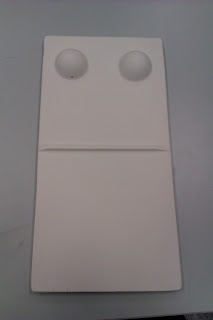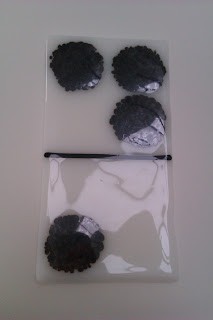For the brief of ‘The
Emperor’s New Clothes’, analysis of the story highlighted the aspect of social
conformity to me which I began to focus on to direct my project. Conformity is
evident throughout by the Emperors reliance on others opinions before forming
his own, which I have chosen to represent through the combined use of dominoes
and braille, creating a braille domino.
This was a conscious
decision as I felt that a domino displays the effect of conformity by
representing the impact that conformity has on us as a society by demonstrating
the chain reaction that occurs when an individual yields to a majority
influence. The name ‘Domino’ ultimately derives from the Latin dominus, meaning “lord” or “master.”
Master has connotations of power and therefore portrays the informational
conformity which is displayed within the short story as we look to people with
power to gain answers. Dominoes also maintain an unvaried design as all in the
set are indistinguishable; either black or having some common design, which
relates to the lack of identity an individual can suffer when following the
crowd. The aim and objectives of dominoes also further relates to the concept
through blocking the opponent therefore obstructing individuality, and to
create equal values which then relates to conforming to correspond with others.
The input of braille which
spells ‘conform’ is an obscured instruction towards the viewer and
fundamentally society, relating to the story where we seek answers from people
who we believe to have more ‘power’ than us, therefore following what we believe
to be the right thing. Braille is a tactile writing system used by the blind,
and in this case, is combined to raise awareness of our failure to recognise
the effects of conformity. The braille also conveys the attitude of conformity
by spelling out this instruction in a less than conventional way, illustrating
that society appears to be oblivious, just like the Emperor, to the effects of
conformity and the way it is inflicted upon society by those with the power to
do so.
In the case of reading
conformity, we often look for alphabetical letters to read, but by replacing
letters with braille, I am stimulating another sense of touch and therefore
encouraging a different approach and reawakening the way we view things. Most
individuals would not know what the braille reads, some may not know it is
braille upon the dominoes at all, but once it is recognised, it can be read and
then acknowledged, in the same way that it took the young boy to point out to
the town that the suit never existed.
The whiteness that
overwhelms the piece is representational of the loss of identity that comes as
a result of conformity, by changing ourselves to fit in with others. Relevant
research into the colour white states that it also conveys isolation and
emptiness which expresses the feelings felt by someone who feels the pressure
to conform, similar to the Emperor’s situation; they fear being an outcast
therefore adapts to suit the company they are in. White is also an unspoiled
colour, depicting a society overcome by conformity as everyone shares the same
opinions and values with no real individuality existing and since white
provides little stimulation towards our senses, this counteracts with the use
of braille. Intuition in the sense of conformity is overruled when an ambiguous
situation arises, therefore avoiding what we might already know just to follow
the majority. The placement of the dominoes finally displays an unavoidable
stance, as conformity is exposed for the viewer to interpret and recognise,
again reinforcing the collective mentality that is created by conformity.


















































